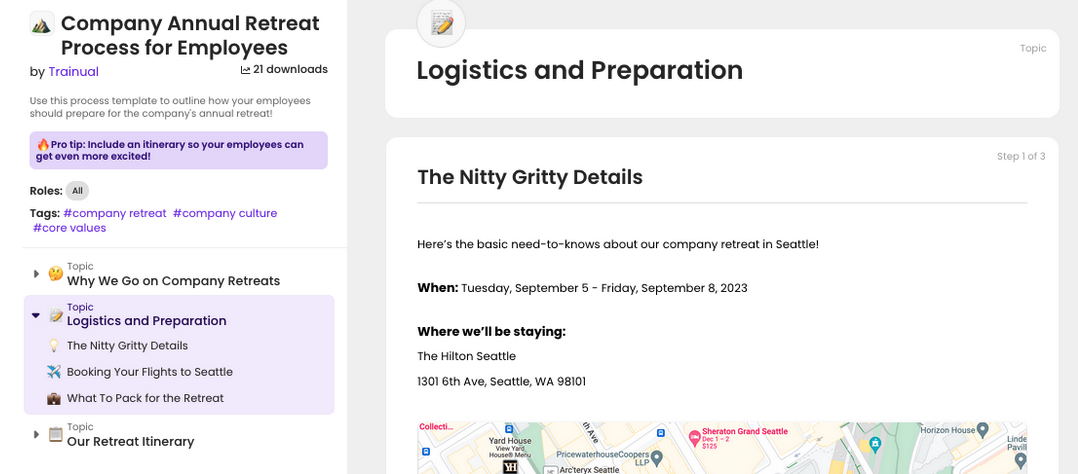Tips for planning your next company retreat (with a free template!)
February 14, 2024
Don’t miss next week’s “Inside the Process” — Trainual’s own people ops manager Tara Montoya is joining the crew to talk about the right way to onboard new employees. Come with all your onboarding questions next Wednesday, February 21, at 9 a.m. PST/12 p.m. EST. Register now!
Hot off the SMB press this week:
- Prepare your employees for the next company retreat with this template.
- When slowing down is better for your business decisions.
- Your how-to guide for setting training order in Trainual.
- How planning the right retreat for your business can reap maximum benefits.
STARTER PACK
Template of the week: Company Annual Retreat Process for Employees

Ahh, the company retreat: a time for relaxation, rejuvenation, and connection across your team.
But, before you can sit back and put your feet up, there comes the planning. Where you’re going, how you’ll get there, what you’ll do there — and the hundreds of tiny details that come with those decisions. And most importantly, how you’ll share all your plans with your employees.
You could send out a handful of emails or Slack messages explaining everything about the retreat — but then you’ll have to send follow-up messages if anything changes, or answer the same “What should I pack?” question 50 times. Or…
🌴 …you can make use of our Company Annual Retreat Process for Employees template. Have all your important annual retreat details in one easy-to-access place, update information as needed, and keep track of who’s reviewed the material. All it needs is your company’s retreat info, and it’s ready to share with your team!
Want more templates to help you build your business playbook? Check out our entire template archive of free, multimedia-enhanced, and customizable policy, process, and role starters. New to Trainual? Get a demo.
SLOW AND STEADY
8 times slowing down will better serve your business

Who’s got time to slow down? We gotta go, go, go.
There are a lot of reasons why businesses need to keep their foot on the gas pedal. Whether you’re trying to make a name for yourself, break into a crowded industry, or scale, running a successful company can hinge on how fast you make decisions and pivot.
And we’re not saying you have to slow down everything about your operations. But there are some who believe that taking a slower approach can have big benefits for business — Stanford management professor and NYT bestseller Bob Sutton recently posted on LinkedIn about how “strategic slowness will be the key to success for innovative leaders and companies in the coming year."
What’s strategic slowness?
Think of it as slowing down at the right times. AKA, choosing specific moments to slow down at work to produce better results — and prevent wasting time later down the road.
Here are eight moments where slowing down is more beneficial than moving fast to save time:
- Big, irreversible decisions. The very term “irreversible” means these choices are permanent. Taking the time to make the right decision is crucial — and worth the extra time you spend.
- Complicated issues. Researchers found that people with greater deep-thinking ability tend to approach complex problems more slowly, but with greater accuracy — because it prevents them from reaching flawed conclusions.
- Connecting with customers. While it may seem better to help as many people as possible, making the space and time to really connect with the customers you serve is more advantageous than getting them in and out the door as quickly as possible. Of course, building deeper relationships takes more time, but it's time well spent.
👉 Check out five more examples.
TRAINUAL TIPS & TRICKS
Why you should set the order of your training in Trainual

When you use groups to share content with your new hires, they’re assigned a bunch of subjects at once. Ones that have to do with their role, department, location, and more. But, you probably want them to learn the company basics first — things like your story, mission and vision, core values, target market, and so on.
So, how do you make sure they learn those things first when they jump into Trainual for onboarding?
Enter the set training order feature. Just head to the Content page, click “Set training order,” and drag and drop your subjects to be in the order you’d like. Whatever order you set on that page will reflect in the “To do” section on each of your employees’ home pages — showing them where to start and what to learn next on their training journey.
👉 See what setting your training order looks like in action.
Psst… hey you! We’re releasing exclusive Trainual tips and tricks on LinkedIn. Follow for more best practices.
F IS FOR FRIENDS THAT DO STUFF TOGETHER
How to plan a company retreat that actually benefits your business
Just seeing the words “company retreat” gets us excited. Why? Let’s talk benefits:
- Retreats are great opportunities for team building, which can improve communication and trust across the board.
- Junior- and senior-level employees have the chance to socialize without the high-level stakes of the regular work week.
- They can boost employee morale and combat the loneliness that remote workers can experience.

And company retreats don’t have to be long or expensive.
A local hotel or lodge within driving distance for most employees can be the perfect setting for your next company retreat. And even one to two nights is enough time to give your team a reprieve from the stresses of work without heavily disrupting your operations.
Here are a few more tips for planning your retreat:
- Don’t overpack your schedule. Your retreat should have a mix of fun and business-related activities. But, don’t forget to give your employees some personal time to recharge, relax, or explore.
- Get employee input. If you’ve done company retreats before, be sure to get some feedback from employees to make the next one even better. And if you’re planning your first, get some ideas from your team. Not everyone’s ideas can be used — and that’s okay — but it’s still important that your employees know they’re being heard.




